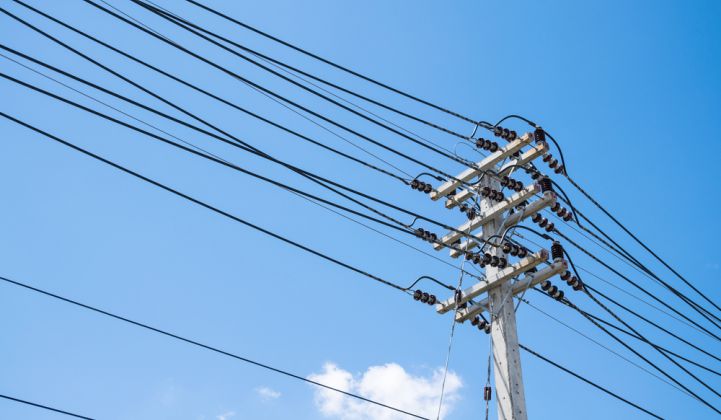Earlier this month, Silicon Valley startup Varentec marked a milestone in its decade-long quest to bring next-generation power electronics to the grid edge — a full-scale commercial deployment with Xcel Energy in Colorado.
Over the next two years, Xcel will deploy 2,000 of Varentec’s ENGO devices across 472 circuits serving the city of Denver. The ENGO (Edge of Network Grid Optimization) units are pole- and pad-mounted boxes, capable of injecting and absorbing reactive power to control distribution line voltages, both independently and in concert with its own grid edge management software.
If all goes well, Xcel plans to deploy a total of 4,350 ENGO units as part of its conservation voltage reduction (CVR) project, which accounts for roughly $125 million of its $612 million grid modernization plan approved by state regulators last year.
By keeping specific low-voltage circuits within acceptable ranges, the ENGO units are expected to increase the overall efficiency savings of its CVR program by roughly 1 to 1.5 percent — a huge amount when spread across a territory with an average 2.4 gigawatts of load and a 5-gigawatt peak.
The Xcel project is a big one for a company that has only about 2,500 units operating in the field today, according to CEO Guillaume Dufossé. Almost all of these are part of utility pilot projects, such as the ones it has run with Duke Energy or Southern Company. Xcel itself ran three pilots over the past three years to prove up the technology’s performance and value, he said.
But Xcel’s contract represents an important “tipping point” for Varentec, Dufossé believes. “We’ve piloted it to death — demonstrated the performance, demonstrated the economics, demonstrated the overall returns for utilities,” he said in a Thursday interview. “It took forever to get from this demonstration phase to the moment when a utility is pushing the button.”
This time lag has plagued Varentec’s competitors in the nascent field of distribution grid power electronics. Its primary competitor, Gridco Systems, closed its doors and put its intellectual property up for bid early this year. A smaller competitor, GridBridge, was acquired by Ermco, a Tennessee-based distribution transformer manufacturer, for an undisclosed price.
That has left the field clear for Varentec to take part in what Dufossé said could be a new wave of CVR and volt/VAR optimization (VVO) projects, based on policy action in Illinois and California, as well as Ontario Province in Canada, he noted.
In Illinois, the Future Energy Jobs Act, passed in December 2016, nearly doubled the state's energy-efficiency goals, and specifically included CVR as an eligibile technology for utilities ComEd and Ameren to invest in to meet them, he said. Ontario has approved CVR investment as efficiency spending through its In Front of the Meter Conservation program, he added.
And California’s 2015 SB 350, which set the state’s new renewable energy, energy efficiency and electric vehicle goals, also specifically approves “programs that save energy in final end uses by reducing distribution feeder service voltage,” a CVR, as an eligible efficiency investment.
These state policy commitments to CVR could help open up what’s been a slow-to-develop market, and push utilities that have already invested in high- and medium-voltage CVR schemes to seek out technologies that can extend viability and control into the low-voltage system, he said.
In that role, Varentec’s technology complements that of companies like Utilidata and DVI, which use grid-tied sensors and smart meters to inform CVR systems, as well as the core CVR systems and hardware from grid giants like Schneider Electric, ABB and General Electric, he said. The ENGO units simply add the ability to prevent under-voltages on problem circuits, allowing CVR systems to push systemwide voltages to lower levels more often.
And these layers of technology, when used in concert, can deliver energy efficiency at a cost of about 1 to 1.5 cents per kilowatt-hour, competitive with traditional utility returns on efficiency investment, Dufossé said. That figure, derived from Varentec’s deployed systems, includes hardware, software, installation, ongoing operations, and all other aspects of keeping it running through its lifespan.
“We’ve been struggling for a long time on the technology adoption,” he said. “Now the technology adoption is right there. The second piece we need is the regulatory support.”
Varentec, which has raised about $43 million from investors including Khosla Ventures, 3M New Ventures and Bill Gates, as well as funding from the Department of Energy’s ARPA-E program, has seen the greatest success for so far in the CVR and VVO role. But its ENGO devices are also being used to mitigate voltage sags and swells on solar-rich distribution circuits on the island of Oahu, as part of a long-running set of projects with utility Hawaiian Electric.
“We’re getting very close to the demonstration of our second business case, managing the hosting capacity of distribution feeders,” Dufossé said. Like Xcel, HECO has been putting Varentec through its “pilot, pilot, pilot” stages, starting with 40 devices on one feeder in 2016, and expanding to 100 units on six feeders in December. But the utility’s $205 million grid modernization plan approved by the Hawaii Public Utilities Commission in February calls for deploying about 2,600 Varentec devices, he said.
--
Grid Edge Innovation Summit is the leading future energy conference that will examine the energy customer of tomorrow and how new innovative business models are quickly emerging. Join us as we bring together the most forward thinking and prominent members of the energy ecosystem and as our research team explores the future of the market.




